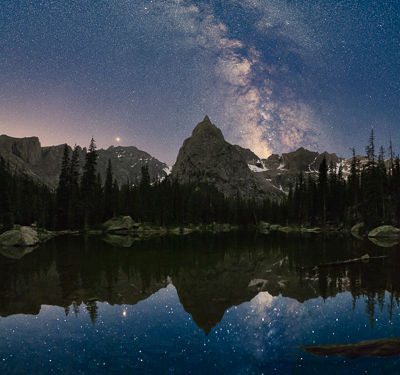
Artistic Philosophy

Sunrise above Lake Isabelle, Indian Peaks Wilderness, Colorado
I believe that authenticity still matters. Or, to put it more precisely, I believe a landscape photograph can only have lasting impact if it is an authentic record of a truly memorable event. Authenticity is at the core of my artistic philosophy. I think we value landscape photographs primarily because they allow us to vicariously experience the wonder and joy that the photographer felt when they were standing there. If the photograph has been constructed in some way rather than captured, and we realize that the photographer never felt the emotion that the image seems to be conveying, we feel manipulated and betrayed.
I recognize the difficulty of defining a "constructed" image. There's a large gray area in between absolutely straight photography and clearly surreal images. In a wide variety of ways, our visual system does not see the world the way our sensors do. But there is also a clear line beyond which everyone can agree, "That's not what you saw." Adding elements that weren't there and subtracting elements that were is certainly beyond that line.
In the digital age, even more than in the film era, the impact and meaning of an image is determined as much by the intentions and integrity of the photographer as it is by the content of the image. While this has always been true of photography, the advent of digital has brought the issue into much sharper focus. I want the viewer of my images to exclaim, "Wow! What a beautiful world we live in!" not think, "Wow! That guy really knows Photoshop." I want to be able to tell my viewers, "What you see in my prints is what I saw through the lens."
When I became a professional landscape photographer in 1993, virtually all landscape photographs were taken in daylight, and my distinction between captured and constructed images seemed quite clear-cut. Then cameras became available that could capture the night sky as we see it, with apparently stationary stars. A new genre within landscape photography was born: night photography. I started shooting landscapes on moonless nights, when the only light sources were starlight and sky glow. The images revealed an amazing abundance of stars as well as the detailed structure of the Milky Way. Suddenly I faced a conundrum: how can I claim that my prints reveal what I saw through the lens when it's so dark I can't see anything through the lens?
In a way, the problem was ironic. For years I had battled the limitations of the capture medium. My philosophy was never, "What you see in my prints is what the camera recorded." That was always unsatisfying because in daylight my eyes could always see much better detail in the highlights and shadows than the camera could.
Now for the first time I had a camera that was better than my visual system, at least in terms of its ability to record extremely faint light at night. My eyes, no matter how well dark-adapted, could barely glimpse the colors and details my camera so easily recorded. Should I suppress those colors and create a near-monochrome image that resembled what I actually saw? Or should I celebrate the camera’s ability to reveal an unseen world and show night scenes in color as the camera recorded it? I experimented with desaturating my night images or converting them to black and white, and concluded quickly that while they might be closer to a literal representation of what I saw, they came nowhere close to evoking the emotions I felt when I was standing there.
I returned to the idea of rendering night scenes in color but quickly ran into another conundrum. The colors my camera recorded sometimes seemed jarringly out of sync with what I imagined those colors ought to be. We all have a lifelong association of the sky with the color blue. Sky is a memory color, one of those colors where we tend to substitute what we want to see (e.g., an idealized, pure blue) for what we actually

Milky Way over Lone Eagle Peak, Indian Peaks Wilderness, Colorado
saw. It’s also a color where we tend to have strong opinions about what looks “right.” On a moonless night, however, the sky is not blue. Its exact color varies, but it is often a shocking shade of green. So should I continue to celebrate my camera’s ability to record the unseen, or should I change the color of the sky to the blue I was expecting and that feels somehow “right”?
Ultimately, I reached this conclusion: photographing in color at night is like shooting in black-and-white during the day. It is an inherently subjective process. My goal at night is to create an image that captures the feeling I had as I stood there under a magnificent starry sky. To that end, I shift the color of the sky toward blue while preserving the color of the brightest stars, which I can actually see with dark-adapted eyes. I shift the color of the land slightly towards blue to help preserve a nighttime feel. If the image shows the Milky Way, a lunar eclipse, a meteor shower, the aurora, or star trails over a particular mountain or desert spire, it's because I actually saw those celestial phenomena soaring over that landscape. Are these images "authentic"? Certainly not in the sense that they show precisely what I saw, since my eyes couldn't see the colors these images depict. I do hope, however, that they evoke for you the same emotions that I experienced as I captured these images, and that they are authentic in that sense. Authenticity is still at the core of my artistic philosophy.
Read my resume of publication credits
